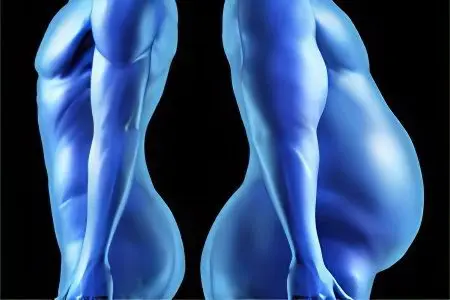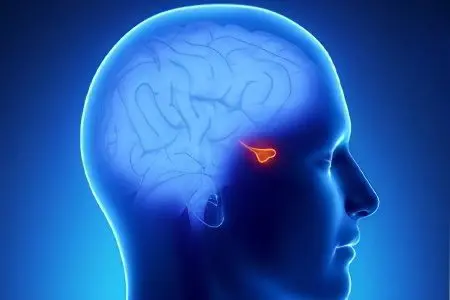Contents

Syndrome Itsenko-Cushing – This is a pathological combination of symptoms that occur against the background of a disease such as hypercortisolism. Hypercorticism, in turn, develops as a result of disturbances in the work of the adrenal cortex with the release of high doses of the hormone cortisol, or after prolonged use of glucocorticoids. Itsenko-Cushing’s syndrome should not be confused with Itsenko-Cushing’s disease, since the disease is a consequence of disorders in the work of the hypothalamic-pituitary system.
Steroid hormones – glucocorticoids are of great importance for the normal functioning of the human body. They are directly involved in metabolism, are responsible for maintaining a large number of physiological functions. So, the hormone ACTH is responsible for the work of the adrenal glands, which contributes to the production of corticosterone and cortisol. The hormones produced by the hypothalamus, liberins and statins, are responsible for the functioning of the pituitary gland. As a result, the body functions as a whole, and if at least one link is disrupted, many processes fail, including an increase in the amount of glucocorticoid hormones produced. Against the background of this condition, Itsenko-Cushing’s syndrome develops.
According to statistics, women are 10 times more likely to suffer from manifestations of this syndrome than men. The age at which pathology debuts can vary from 25 to 40 years.
Symptoms of Itsenko-Cushing syndrome
The symptoms of Itsenko-Cushing’s syndrome are diverse and are expressed as follows:
More than 90% of patients suffer from obesity. Moreover, the distribution of fat follows a certain type, which in medicine is called cushingoid. The greatest accumulation of body fat is observed in the neck, face, abdomen, back and chest. At the same time, the patient’s limbs remain disproportionately thin.
The patient’s face is rounded, becomes like the moon. The complexion is purple-red, has a cyanotic hue.
Often, patients develop a buffalo hump or a buffalo hump. So called fat deposits in the region of the seventh cervical vertebra.
The skin on the palms on the back becomes very thin, acquires transparency.
As the disease progresses, muscle atrophy increases. This leads to the formation of myopathy.
The symptom of “sloping buttocks” and “frog belly” is also characteristic of this pathology. At the same time, the muscles of the buttocks and hips lose volume, and the stomach hangs down due to the weakness of the muscles of the peritoneum.
Often a hernia of the white line of the abdomen develops, in which the sac protrudes along the midline of the peritoneum.
The vascular pattern on the skin becomes more visible, the dermis itself acquires a marbled pattern. Due to increased dryness of the skin, areas of peeling are observed. At the same time, the sweat glands begin to function more strongly. The fragility of the capillaries leads to the fact that bruises easily appear on the patient’s body.
Crimson or cyanotic striae cover the shoulders, abdomen, chest, thighs and buttocks of the patient. Stretch marks can reach a length of 80 mm and a width of 20 mm.
The skin becomes prone to acne, often begin to form spider veins. Hyperpigmented areas are observed.
Osteoporosis is a frequent companion of patients with Itsenko-Cushing’s syndrome. It is accompanied by thinning of the bone tissue and is expressed in severe pain. People are becoming more prone to fractures and bone deformities. Against the background of osteoporosis, scoliosis, kyphoscoliosis develops. The thoracic and lumbar spine are more vulnerable in this regard. As the compression of the vertebrae progresses, patients stoop more and more, eventually becoming shorter.
If Itsenko-Cushing’s syndrome debuts in childhood, then the child has a lag in growth compared to peers. This is due to the slow development of the epiphyseal cartilages.
Such symptoms of Itsenko-Cushing’s syndrome as cardiomyopathy in combination with arrhythmias, heart failure, arterial hypertension can lead to death.
Patients are often inhibited, prone to depressive moods, and suffer from psychoses. Frequent suicide attempts.
Diabetes mellitus, independent of pancreatic diseases, is diagnosed in 10-20% of cases. The course of steroid diabetes is quite mild and can be corrected by taking specialized drugs and dietary nutrition.
Perhaps the development of peripheral edema against the background of nocturia or polynuria. In this regard, patients suffer from constant thirst.
Men suffer from testicular atrophy and are prone to feminization. They often have potency disorders, gynecomastia.
In connection with the suppression of specific immunity, the development of secondary immunodeficiency occurs.
Women often suffer from menstrual disorders, infertility, amenorrhea and other disorders against the background of hyperandrogenism.
Causes of Itsenko-Cushing’s syndrome

The causes of Itsenko-Cushing’s syndrome are distinguished by experts as follows:
microadenoma pituitary is a benign tumor of the glandular contents, which does not exceed 20 mm in size, but at the same time affects the increase in the amount of adrenocorticotropic hormone in the body. It is this cause that is considered by modern endocrinologists to be the leading one in terms of the development of Itsenko-Cushing’s syndrome and causes pathological symptoms in 80% of cases.
Adenoma, adenocarcinoma, adenomatosis of the adrenal cortex leads to the development of Itsenko-Cushing’s syndrome in 18% of cases. Tumor growths disrupt the normal structure and functioning of the adrenal cortex, causing a malfunction of the whole organism.
Corticotropinoma lungs, ovaries, thyroid, prostate, pancreas and other organs causes the development of a pathological syndrome in no more than 2% of cases. Corticotropinoma is a tumor that produces corticotropic hormone, which causes hypercortisolism.
It is possible to develop the disease with prolonged use of drugs, which include glucocorticoids or ACTH.
The course of the disease can be progressive with full development of symptoms over a period of six months to a year, or gradual with an increase in symptoms over a period of 2 to 10 years.
Diagnosis of Itsenko-Cushing syndrome
If the patient has a suspicion of Itsenko-Cushing’s syndrome, but the intake of corticoid hormones from the outside is completely excluded, then it is necessary to determine the true cause of hypercorticism.
For this, modern specialists are armed with the following screening tests, thanks to which the diagnosis of Itsenko-Cushing syndrome is reliable:
The study of daily urine in order to determine the excretion of the hormone in it. The presence of the syndrome is confirmed by an increase in cortisol in the urine by 3 or more times.
Taking a small dose of dexamethasone. Normally, dexamethasone has a neutralizing effect on cortisol, reducing it by more than 50%. In the presence of the syndrome, this will not happen.
Taking a large dose of dexamethasone makes it possible to distinguish Itsenko-Cushing’s disease from the syndrome. If cortisol levels remain unchanged from baseline, then the patient is diagnosed with a syndrome, not a disease.
Urinalysis reveals a rise in 11-hydroxyketosteroids and a fall in 17-KS.
A blood test reveals hypokalemia, an increase in hemoglobin, cholesterol and red blood cells.
MRI, CT scan of the pituitary and adrenal glands can determine the presence of a tumor, which is the source of hypercortisolism.
Radiography and CT of the spine and chest can determine the presence of complications of the pathological condition.
Treatment of Itsenko-Cushing’s syndrome

Treatment of Itsenko-Cushing’s syndrome is within the competence of an endocrinologist. If it has been established that certain drugs are the cause of the syndrome, then they must be excluded. Cancellation of glucocorticoid drugs should be carried out gradually, followed by replacement with other immunosuppressants.
If hypercortisolism is endogenous in nature, then it is necessary to take drugs that affect the production of cortisol. These can be drugs such as: Aminoglutethimide, Ketoconazole, Chloditan, Mitotan.
Surgery is necessary if a tumor is found in one or another part of the body. If the formation cannot be removed, then the removal of the organ as a whole is indicated (most often this is an operation to remove the adrenal glands). Or the patient is prescribed a course of radiation therapy of the hypothalamus and pituitary gland. Radiation therapy is carried out both separately and in combination with drug correction or after surgery. This allows you to achieve the best effect and minimize the risk of relapse.
Depending on the symptoms of Itsenko-Cushing’s syndrome, patients are given appropriate therapy aimed at stopping the clinical signs of pathology.
It is possible to prescribe the following medicines:
Antihypertensive drugs (spironolactone, ACE inhibitors);
Potassium preparations;
medicines to lower blood sugar levels;
Drugs for the treatment of osteoporosis (calcitonins);
Vitamin D;
Anabolic steroid;
Antidepressants;
Sedatives, etc.
It is important to compensate for impaired metabolism.
If the patient had to undergo surgery to remove the adrenal glands, then he is prescribed hormone replacement therapy for life.
As for the prognosis, the lack of treatment in 50% of cases leads to death, since irreversible consequences occur in the body. In other cases, the prognosis depends on the cause of the development of hypercortisolism. In the presence of benign corticosteroma, the prognosis is favorable, and in 80% of cases, after removal of the tumor, the adrenal gland begins to function in full.
Five-year survival after removal of a malignant tumor is in the range of 20 to 25%. If there is chronic adrenal insufficiency, then hormone replacement therapy is taken throughout life. Patients with Itsenko-Cushing’s syndrome must abandon difficult working conditions and adhere to a normal daily routine.









